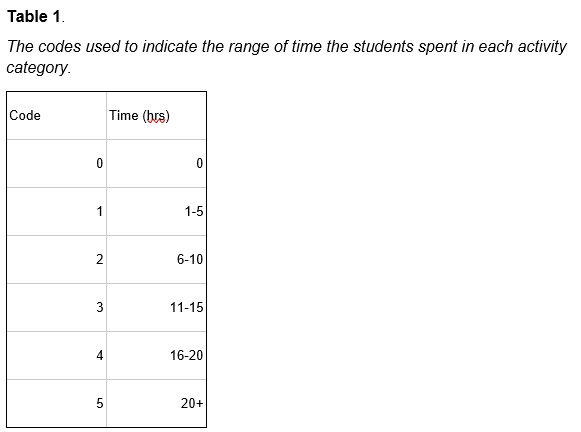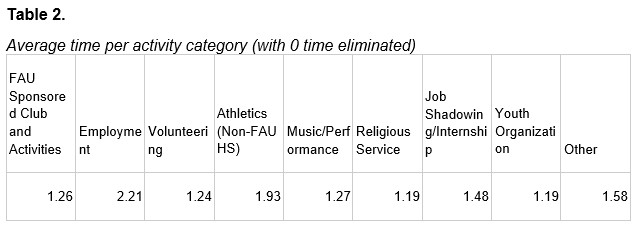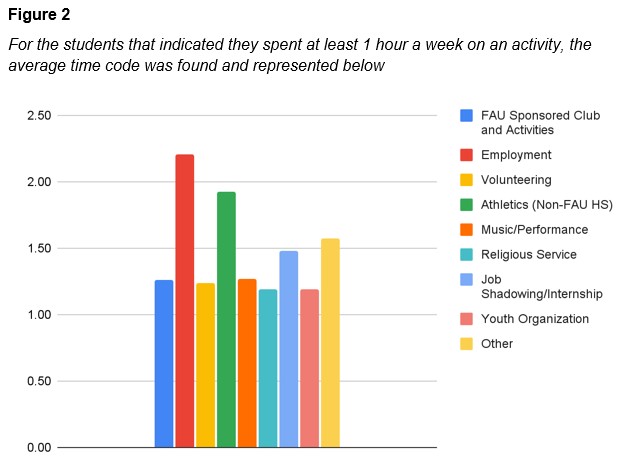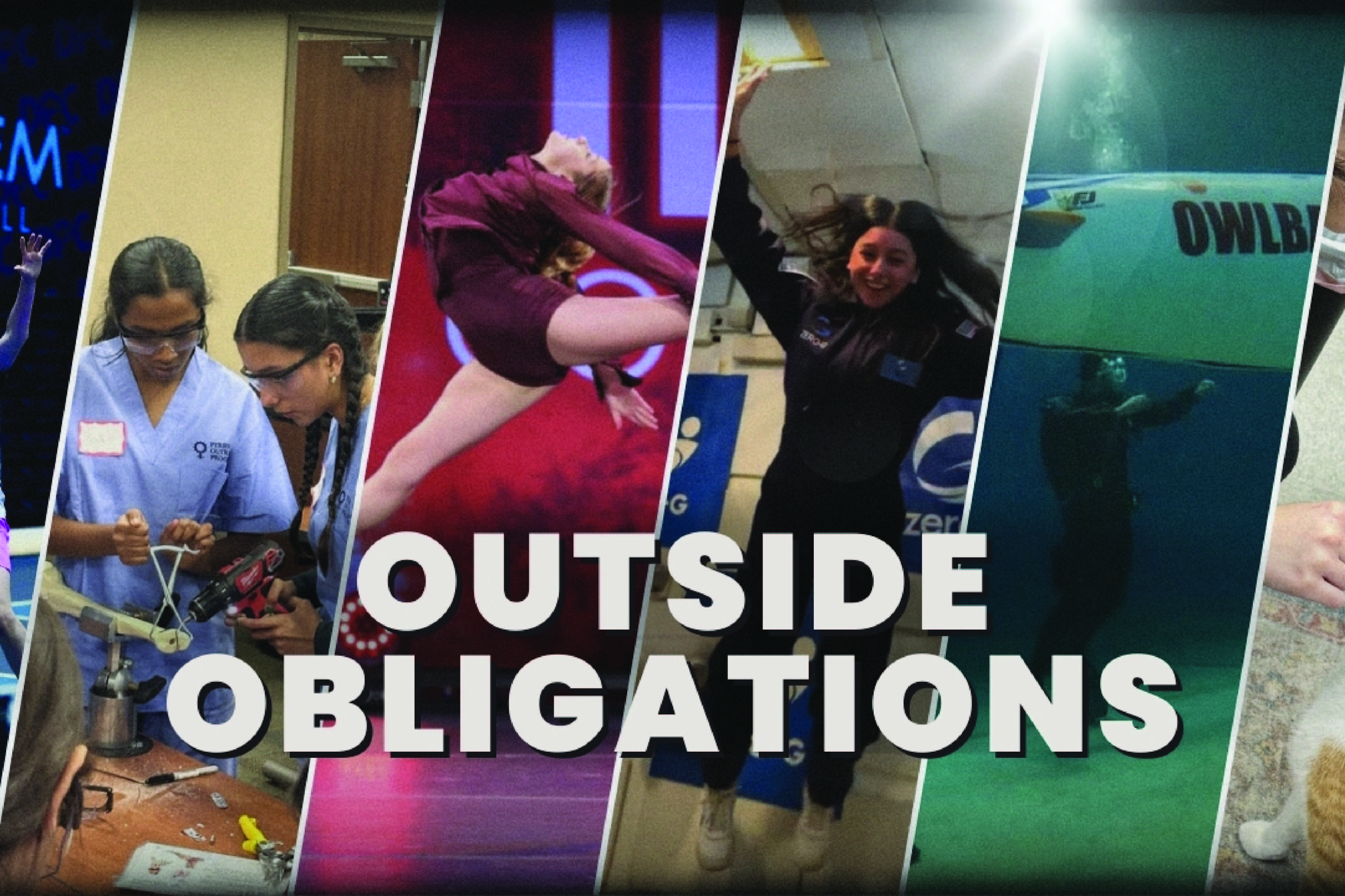Project Rationale
This project will impact our school community by helping us gain better insight into our students’ time obligations. We currently have robust data on our students’ school-sponsored activities, but we are completely missing activities they do outside of our school community. By adding the data from this project to our school data, we will be able to better understand the connection between student performance and their time commitments. We will also be able to look deeper into data on students who are highly-engaged versus students who are very low in their level of engagement. Outside of our school community, educators and administrators should understand that students are active in many school and non-school sponsored activities and both of these forms of engagement will have an impact on their time and wellbeing. Understanding how extracurricular activities both have the potential to positively impact and negatively impact students will help educators, administrators, and parents advise students in their commitment levels to have the greatest positive impact.
Project Context
This study took place at Florida Atlantic University High School, which is a dual-enrolled high school program. Our program selects students based on their academic aptitude and motivation. Our school offers 26 extra-curricular activities that span a wide variety of interests, but our students engage in community and university organizations that are not overseen by FAU High School. All of the 9-12th grade (N = 680) students were sent a survey about their outside obligations. As of November 2024, 229 students have completed the survey (33.7% completion rate). In the spring semester, the survey was sent out again, with a focus on their activities in the spring instead of the fall (taking into account changing sports schedules). In the spring, students who were identified as highly engaged in outside activities were invited to participate in a focus group.
Supportive Literature
Extracurricular activities have been identified as providing a wide variety of benefits to adolescents and young adults. A review study by Ribeiro, Malafaia, Neves, and Menezes (2024) found that extracurricular activities have positive effects such as academic success, increases employability of university students, and helps to connect the students to adults in their university community. They also saw some negative effects associated with students from lower socioeconomic backgrounds, but due to the affordability of participation being a barrier. The lower SES students were unable to afford participation in extracurriculars and therefore missed out on the benefits that were gained by their higher SES peers.
Extracurricular activities can become a key setting for adolescent development. In a review study by Feldman and Matjasko (2005), a review of 44 papers supported the link between activity participation and academic achievement, but that the effect was moderated by a number of factors. These factors included gender (male athletes saw a greater positive impact of playing school sports on academic achievement than female athletes), the type of activity (structured activities had a positive impact on student achievement but employment and unstructured activities had a negative impact), and the peer group dynamics (some peer groups encourage an academic focus while others engaged in risky activities such as partying which may negatively impact student grades). Furthermore, when maternal education and math/verbal scores were included in their models, the positive impact of extracurricular participation was no longer significant. When looking deeper into the link between sports participation and self-esteem, positive effects were moderated by the position the student played, with higher-status sports roles, such as quarterback, increasing self-esteem while students that were less successful in their athletics suffered a reduction in self-esteem.
Additional research conducted by Haghighat and Knifsend (2019) defined several key mediating variables of the association between extracurricular participation and educational attainment -- time spent on homework, value placed on education, and educational expectations. In the study, the authors conducted a longitudinal study that followed over 15,000 10th grade students through 12th grade. The study found that extracurricular involvement was positively associated with educational attainment and mediated by educational expectations. The results saw that there was a positive association between time spent on homework and a greater value placed on education, which was moderated by both the breadth (how many activities a student was involved in) and intensity (time commitment) of the extracurricular activity. Students who rated higher in extracurricular participation (breadth and intensity) were more likely to complete higher education certificates and/or degrees within eight years of completing high school. The link between time spent of homework, value placed on education, educational expectations, and participation in extracurricular activities was likely linked to the students’ motivation, establishing personal academic standards, increasing sense of accomplishment, and deepened relationships between activity participants (Haghighat & Knifsend, 2019).
What is still unknown is the role of non-school sponsored extracurricular activities on academic achievement. It is clear from the research that participation in extracurricular activities has an overall positive effect on student achievement, but that the view of activity participation needs to be broadly defined in order to capture the full scope of student participation and outcomes.
Research Methods
This study was conducted through a survey that was sent out to all of the FAU High School students, grades 9-12 (N = 680). The survey was sent to students in late September, with a reminder sent one week later.
In the spring semester, the survey was sent out again in February to record data from that time-point. Some students participate in activities, such as sports, that are seasonal (ex: basketball in the fall, track and field in the spring). The goal was to collect data across both Fall and Spring semesters to get a more holistic understanding of student participation.
In addition to surveys, there was a focus group conducted in the spring with students who were identified as “high engagement” with non-FAU High School sponsored activities.
Results
Of the 391 student responses (Fall = 228; Spring = 163; Grade 9 = 131, Grade 10 = 85, Grade 11= 110, Grade 12 = 65), an overwhelming majority of the students reported participating in one or more non-school sponsored extracurricular activities (Yes = 94.8%). When asked about the category of non-school sponsored extracurricular activities they engaged in, the students responded that they participated in a wide variety of activities with volunteering (n = 238), athletics (n = 152), and employment (n = 137) being the three most common activities (see Graph 1). Students often indicated that they participated in more than one non-school sponsored activity.

Students were asked to indicate the amount of time they spent in each extracurricular activity category each week, with the time range coded from 0-5:

In the next step of analysis, data for non-engagement was eliminated for each category and the time spent in each category was averaged (avg = 1.48 on the coding scale as seen in Table 1, approximately 1-10 hours per week). The activity that had the greatest time commitment was employment (avg = 2.21, or 6-10 hours per week), followed closely by athletics (avg = 1.93, or 1-5 hours per week), as seen in Table 2 and Graph 2. On the high end of engagement, one student’s coded time, added across all of their activities was 15, or well over 20+ hours a week (volunteering alone accounted for over 20 hours a week of this student’s time, or a 5 on the time coding scale).


When asked how often they feel like the non-school sponsored extracurricular activities impact them in a positive or negative way, the student responses were generally positive, as seen in Graph 3. 96.7% of the student responses indicated that the activities “always” “often” or “sometimes” were positive. 34% of the students indicated that the activities “always” “often” or “sometimes” had a negative impact (the most common answer was “rarely”, with 52.9% of the responses).

To determine the impacts of non-school sponsored activities on their life and wellbeing versus academic success, students were asked to indicate whether there was an overall positive or negative effect, with the results displayed in Graph 4. Most students indicated that their activities had a positive effect on their life and wellbeing but were more neutral and negative about the effects on their academic success.

After the completion of two rounds of the survey (once in fall and again in spring), students who were highly engaged in non-school sponsored activities were invited to participate in a focus group. Three students (all female) responded and met with the researcher on Zoom.
The questions asked in the focus group revolved around three themes - Skills and benefits, balancing academics and extracurricular activities, and connection (or lack of connection) to the school community. The student responses indicated that the activities brought positive effects on their lives, but they also discussed how they had to manage their time closely and often felt the stress of not having enough time to relax.
Quotes of each of the five identified themes are as follows:
Skills and benefits . Students were asked to talk about the benefits or skills they gained from participating in their activities. They talked about career preparation outside of the classroom, such as hands-on engineering clubs, and the ability to get outside and exercise, in the case of a student that participated in league soccer. They also expressed feeling passionate about their clubs, even if there was not a direct academic benefit.
SB1: “I really like working with my hands, and I feel like a lot of the clubs that I looked for outside of FAU allowed me to focus also on my career like deciding if I really wanted to go into a certain field, and by trying those different things that really got me to work with professionals that were already doing that. [The clubs] really allow me to narrow down what kind of pathway I want to focus on in college.”
SB2: “I do soccer for exercise, and I've just been liking it since I was young. So it's just like a passion for me now.”
DA: “I think I learned like, I developed my problem-solving skills… I guess through research. Because like in biomedical research, there's a lot of like troubleshooting experiments and stuff like that…”
Balancing academic and extracurricular activities. Students were asked to discuss how they balanced their time between academics and extracurricular activities. The students talked about the need for time management skills, lack of free time, and the stress that can build when they feel that they cannot complete everything to their standard in the required timeframe.
SB1: “I think there was one point where I had to schedule every single hour in a time block to figure out how it's gonna fit everything in a single day. So it's definitely a challenge to put that all into a schedule.”
Connection (or lack of connection) to the school community. In the focus group, students were asked if they felt more or less connected to their school community. They seemed to notice both positive and negative aspects when looking at connection to their school community. On one hand, they were able to meet upperclassmen that they would not have met otherwise, but on the other hand, they spent a lot of time with students who did not attend our school. They also mentioned that they spent time with younger students and older adults, giving them a wider network of friends, but that often sacrificed connections to their school.
SB1: “I feel like I was surrounded by either people much younger than me when I was helping in classrooms or people a lot older than me, when I was working with internships or shadowing opportunities.”
Implications
The results of this project showcased a few important findings. First, nearly all of our students are highly engaged in a wide variety of activities that are not linked to our high school program. The students who responded spend a great deal of their time outside of the classroom engaged in these activities, working part-time jobs, volunteering, playing on sports teams, conducting research, and joining university clubs. The students had a positive viewpoint of the impacts of their extracurricular activity involvement on their lives in general, but when looking at the impact more specifically on their life and wellbeing versus the impact on their academic success, the impact was more mixed. The students reported that the impact was positive on their life and wellbeing, which aligns with the literature (Ribeiro, et al., 2024), by providing the students with opportunities to meet new friends, learn new skills, and prepare them for careers outside of school. The impact on their academics, however, was more complicated. When asked to discuss the impacts, students reported needing to find time to balance both their schoolwork and extracurriculars, and commented that they often felt stressed balancing their workload and extracurricular time. This effect was likely moderated by the time commitment of each activity -- for example, working a part time job would cause more stress due to the set time commitment but a recreational club would not have such a large impact on the time they needed in order to prepare for their courses.
This study will help the teachers, club advisors, academic counselors and school administrators at our high school understand the depth and breadth of our students’ after-school engagement. This knowledge will help administrators advise students more effectively when encouraging students to engage in extracurricular activities. While it might make sense to encourage students to participate in as many extracurricular activities as possible, with particular emphasis on school sponsored activities, it is important to remember that the students’ may already be committed to other activities. Student engagement must be viewed holistically -- employment, volunteering, athletics, and religious activities may be taking up a lot of the students’ time outside of the classroom. It is also important to keep in mind the problems of over engagement on both the students’ academic preparation and emotional wellbeing.
References
Feldman, A. F., & Matjasko, J. L. (2005). The Role of School-Based Extracurricular Activities in Adolescent Development: A Comprehensive Review and Future Directions. Review of Educational Research, 75(2), 159-210.
Haghighat, M. D., & Knifsend, C. A. (2019). The Longitudinal Influence of 10th Grade Extracurricular Activity Involvement: Implications for 12th Grade Academic Practices and Future Educational Attainment. Journal of Youth and Adolescence, 48(3), 609-619. https://doi.org/10.1007/s10964-018-0947-x
Ribeiro, N., Malafaia, C., Neves, T., & Menezes, I. (2024). The impact of extracurricular activities on university students’ academic success and employability. European Journal of Higher Education, 14(3), 389–409. https://doi.org/10.1080/21568235.2023.2202874
Appendix
The survey questions were as follows:
- In an average week, are you involved in any activities that are NOT sponsored by FAU High School (employment, FAU clubs/activities, volunteering, athletics, music/performing arts, religious services/activities, job shadowing/internship, youth organizations)
- If yes, what category of non-school sponsored activity do you attend? Choose all that apply.
- In an average week, please estimate the number of hours you engage in each of the following activities. [FAU Sponsored Clubs/Activities]
- In an average week, please estimate the number of hours you engage in each of the following activities. [Employment]
- In an average week, please estimate the number of hours you engage in each of the following activities. [Volunteering]
- In an average week, please estimate the number of hours you engage in each of the following activities. [Athletics (not affiliated with FAU High School)]
- In an average week, please estimate the number of hours you engage in each of the following activities. [Music/Performing Arts]
- In an average week, please estimate the number of hours you engage in each of the following activities. [Religious Services or Activities]
- In an average week, please estimate the number of hours you engage in each of the following activities. [Job Shadowing/Internship (unpaid)]
- In an average week, please estimate the number of hours you engage in each of the following activities. [Youth Organizations (Boy/Girl Scouts, Boys & Girl's Club)]
- In an average week, please estimate the number of hours you engage in each of the following activities. [Other]
- How often do you feel like your non-school sponsored extracurricular activities impact you in a positive way?
- Please select which positive effects you have experienced by participating in non-school sponsored activities. Select all that apply.
- How often do you feel like your non-school sponsored extracurricular activities impact you in a negative way?
- Please select which negative effects you have experienced by participating in non-school sponsored activities.
- Do you feel like your non-school sponsored activities have an overall positive or overall negative effect on your general life and wellbeing?
- Do you feel like your non-school sponsored activities have an overall positive or overall negative effect on your academic success?
- Do you also participate in school sponsored activities (FAU HS athletics, FAU High School clubs)
- Please list the other FAU High School sponsored activities you are in below (athletics/clubs).
- Why do you feel as if there is positive or negative impact of extracurricular activities (both school and non-school sponsored) on your academics?
- Is there anything else you'd like to share with me regarding your non-FAU High School sponsored activities and their impact on your life (academic and beyond)?
The questions in the focus groups were the following:
- Skills learned in their outside activities that impact their academic achievement
- How long have you been involved in your activity(ies)
- How do you feel about the role of your activity in your life?
- What benefit or skills have you gained from participating in your activity?
- Balancing school and outside activities
- Do you think there has been a link for you between your academic success and your outside activity?
- Why or why not do you think there might be a connection?
- Do you ever find it challenging to balance your academics with your activity? Examples?
- What benefits have you experienced due to your involvement in extracurricular activities? Example: improved time management skills
- Connection to school community
- Do you feel more or less connected to our school community because of your activity?
